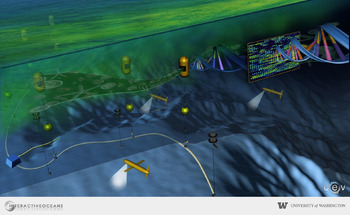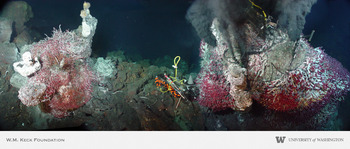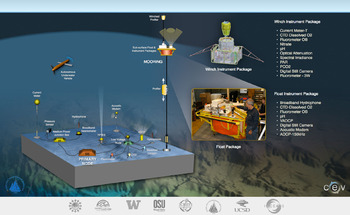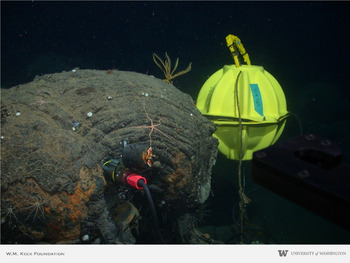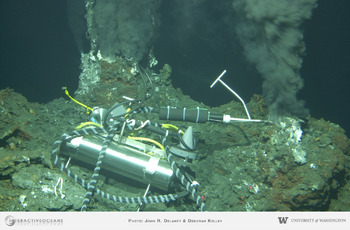The OOI Regional Scale Nodes cabled observatory will reach some of the most extreme environments on Earth:
- Hydrothermal vents on active submarine volcanoes that emit >300°C acidic fluids rich in carbon dioxide and hydrogen sulfide
- Deep-ocean waters at pressures 300 times greater than those we experience on land
- Areas of gas hydrates with exposed methane-ice deposits on the seafloor
- An ocean basin where storms routinely produce >30-foot waves and sustained winds of >40-50 knots.
To understand the processes that operate in the oceans requires development of novel sensor arrays that can withstand harsh environments over time. With ocean science community input, a diverse suite of sensors has been chosen to be deployed on the OOI Regional Scale Nodes at Axial Seamount and Hydrate Ridge and on the full water-column moorings. The high power and bandwidth allow unprecedented data return from this sensor suite in real-time from the seafloor and over full-ocean water depths. Also enabled are returns of stereo high-definition video imagery and high-definition digital stills of vents, methane seeps, and the life that thrives in these extreme environments. Control of these sensors through the OOI Cyberinfrastructure and OOI Regional Scale Nodes Operational Center at the University of Washington will allow interaction with the sensors to change sampling rates, view angles, and response capabilities to dynamic events in the oceans. Such events could include an erupting volcano; large and small seismic events on the Cascadia Subduction Zone that may be linked to release of methane ice into the ocean; coastal and ocean storms; and El Niño and La Niña perturbations to ocean temperature.
The confluence of nanotechnology, ever-increasing computational power, and installation of high-power and bandwidth cables into the oceans will likely lead to unprecedented advancements in ocean sensing within the next decade. High power within submarine environments allows sensors routinely used in land-based laboratories to be exported to the oceans. Example sensors include mass and raman spectrometers for detailed chemical analyses of vent, seep, and ocean fluids and in situ DNA sensors and flow cytometers for genomic analyses. Ample expansion capabilities on the OOI Regional Scale Nodes will allow scientists to adapt and deploy sensors such as these to deep- and shallow-ocean environments.
